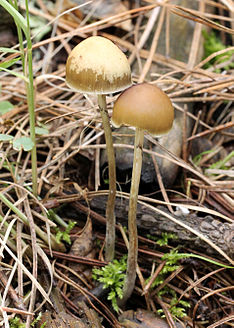Psilocybe aztecorum
| Psilocybe aztecorum | |
|---|---|
 |
|
| in Popocatépetl, Mexico | |
| Scientific classification | |
| Kingdom: | Fungi |
| Division: | Basidiomycota |
| Class: | Agaricomycetes |
| Order: | Agaricales |
| Family: | Hymenogastraceae |
| Genus: | Psilocybe |
| Species: | P. aztecorum |
| Binomial name | |
|
Psilocybe aztecorum R.Heim (1957) |
|
| Synonyms | |
|
|
| Psilocybe aztecorum | |
|---|---|
| Mycological characteristics | |
| gills on hymenium | |
|
|
cap is convex or campanulate |
|
|
hymenium is adnate or adnexed |
| stipe is bare | |
| spore print is purple | |
| ecology is saprotrophic | |
| edibility: psychoactive | |
cap is convex
hymenium is adnate
Psilocybe aztecorum is a species of psilocybin mushroom in the family Hymenogastraceae. Known only from central Mexico, the fungus grows on decomposing woody debris and is found in mountainous areas at elevations of 3,200 to 4,000 m (10,500 to 13,100 ft), typically in meadows or open, grassy forests associated with Hartweg's pine (Pinus hartwegii). The mushrooms have convex to bell-shaped caps 1.5–2 cm (0.6–0.8 in) in diameter, atop slender cylindrical stems that are up to 7.5 cm (3.0 in) long. The color of the caps changes with variations in hydration, ranging from dark chestnut brown to straw yellow or whitish when dry. The base of the stem is densely covered with conspicuous white rhizomorphs, a characteristic uncommon amongst Psilocybe species.
The species was first reported by French mycologist Roger Heim in 1956 as a variety of Psilocybe mexicana before he officially described it under its current name a year later. Named for its association with the Nahua people also called Aztecs, P. aztecorum may have been one of the sacred mushroom species, or teonanácatl (A Nahuatl word translated variously as "sacred mushroom" or "flesh of the gods"), reported in the codices of 16th-century Spanish chronicler Bernardino de Sahagún. The mushrooms are still used for spiritual ceremonies by Nahua Indians in the Popocatépetl region, although this traditional usage is waning. The variety P. aztecorum var. bonetii has smaller spores than the main variety, and is found at lower elevations with Montezuma pine (Pinus montezumae) and sacred fir (Abies religiosa). P. aztecorum may be distinguished from similar temperate species such as P. baeocystis and P. quebecensis by their ranges, and by differences in the morphology of microscopic structures like cystidia.
...
Wikipedia
